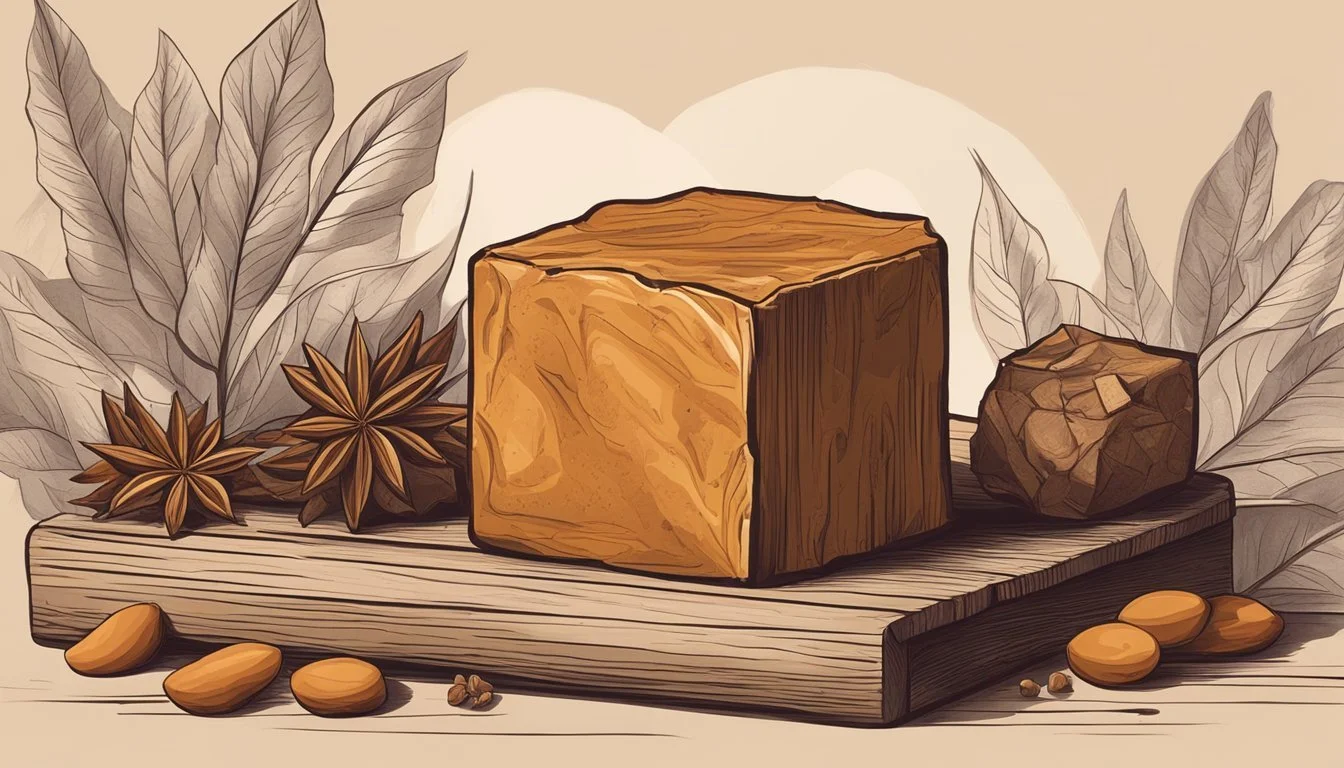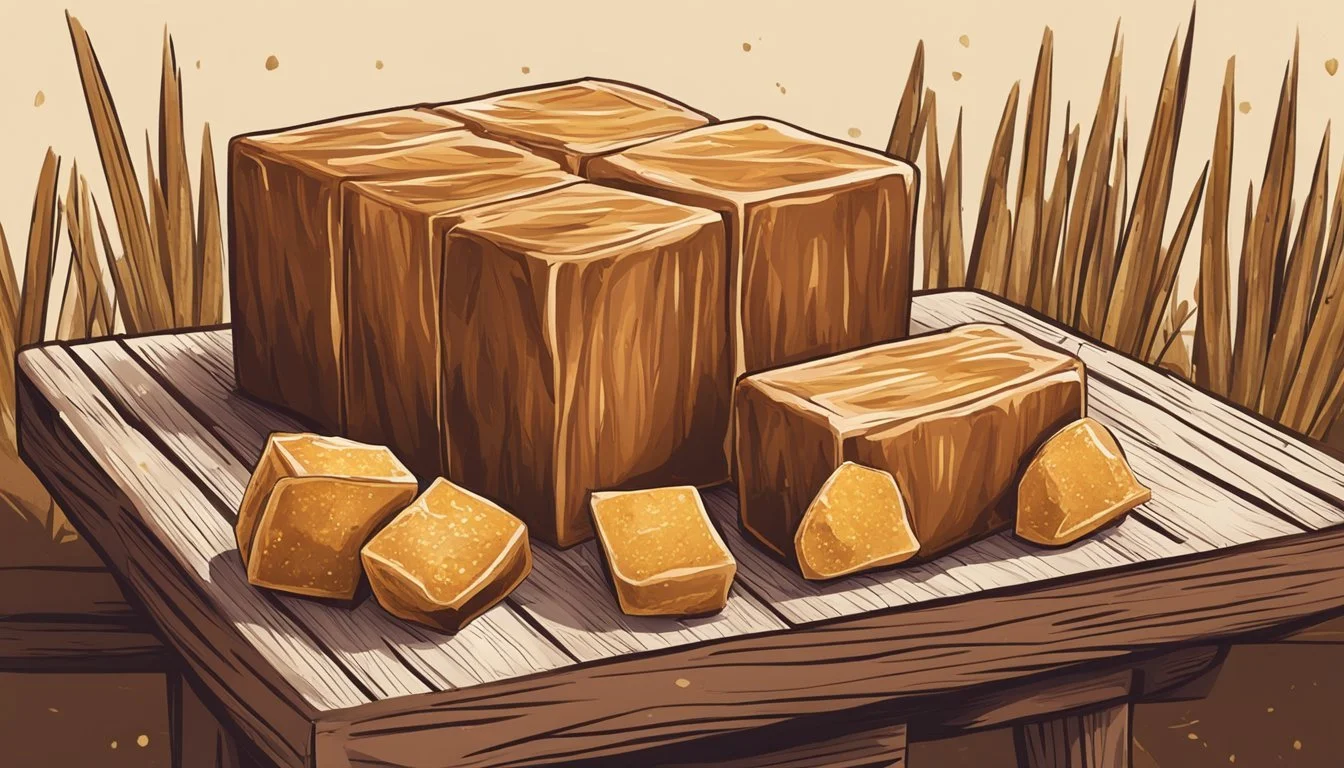How Long Does Jaggery Last?
Shelf Life and Storage Tips
Jaggery (how long does jaggery last?), a traditional natural sweetener widely used in various cuisines, particularly in India, is derived from raw, concentrated sugar cane juice. It is also produced from palm sap. Over time, it has been appreciated not only for its rich, molasses-like flavor but also for its purported health benefits as compared to refined sugar. The shelf life of jaggery is a common concern for consumers who wish to enjoy its flavor and benefits over time.
To assess how long jaggery lasts, one must consider its storage conditions. Jaggery can spoil if exposed to moisture or kept in a hot environment. When stored properly in a cool, dry place, jaggery can maintain its quality for several months. Factors such as exposure to air and humidity can impact its texture and taste, with moisture leading to the risk of mold and bacterial growth.
The unrefined nature of jaggery means that it retains more moisture than granulated sugar, which necessitates careful storage to preserve its shelf life. It's recommended to keep jaggery in an airtight container away from heat sources to prevent it from becoming too soft or melting. Ensuring the storage area’s temperature is between 20 to 25 degrees Celsius (68 to 77 degrees Fahrenheit) can also help in prolonging its lifespan, keeping its natural sweetness intact for an extended period.
Understanding Jaggery
Jaggery is a traditional natural sweetener that is integral to many cultures, known for its unique taste and nutritional benefits. This section will explore its origins, nutritional content, and comparisons with other sweeteners.
Origins and Production
Jaggery, a non-centrifugal sugar, is most commonly produced in India, Southeast Asia, and Africa from sugar cane or palm sap. The process begins with extracting the juice from sugar cane or palm trees, followed by boiling and clarification to remove impurities. As the juice thickens, it transforms into a concentrated, pasty, brown mass that solidifies into jaggery blocks or granules.
Nutritional Profile
Jaggery is appreciated not only for its sweetness but also for its nutrition. It contains minerals such as iron, calcium, potassium, magnesium, and phosphorus. Unlike refined sugar, jaggery retains trace amounts of fiber, protein, and antioxidants. Vitamins found in jaggery include vitamin B and vitamin C, albeit in small quantities. The nutritional makeup contributes to the energy jaggery provides.
Mineral Importance Iron Oxygen transport, reduces fatigue Calcium Bone strength and health Potassium Regulates fluid balance, muscle contractions Magnesium Nerve function and blood glucose control
Jaggery Vs. Other Sweeteners
When compared to refined sweeteners like white sugar or brown sugar, jaggery is considered a healthier alternative due to its unrefined nature. The natural process of making jaggery preserves its molasses content, which imparts a distinctive caramel-like flavor along with natural sweetness. It contains more nutrients than refined sugar, which is devoid of any significant benefits apart from sweetness. Jaggery can substitute for sugar in recipes to offer a deeper flavor profile and add a subtle richness to various dishes.
Shelf Life and Storage
Jaggery's quality and shelf life are heavily influenced by storage conditions, such as temperature and moisture levels. Proper storage is critical to prevent spoilage and maintain the sweetener's natural goodness.
Determining Quality and Shelf Life
Jaggery typically lasts between 6 to 12 months when stored correctly. Its freshness can be gauged by its texture; good quality jaggery should be firm to the touch. Signs of spoilage, such as the presence of mold or a foul odor, are indicators that the jaggery is no longer suitable for consumption. Additionally, the purity of jaggery contributes to its shelf life; contaminants can drastically shorten it.
Optimal Storage Conditions
Jaggery should be stored in an airtight container to protect it from humidity and moisture, which can lead to a softened texture and increase the risks of mold. For maintaining its quality, jaggery should be kept at a consistent temperature of 20 to 25°C (68 to 77°F), away from direct sunlight and heat sources, which can cause it to melt. Conversely, jaggery should also not be kept in an overly dry environment as it can harden and lose its texture. To prevent jaggery from absorbing other odors, keep it separate from strong-smelling substances.
Proper Packaging:
Airtight containers: Glass or metal with secure lids
Avoid: Plastic bags that can trap moisture and cause spoilage
Ideal Conditions:
Temperature: 20 to 25°C (68 to 77°F)
Humidity: Low to moderate
Away from: Direct sunlight, heat sources, and strong odors
Usage of Jaggery
Jaggery, a traditional sweetener predominantly found in India, is utilized extensively in various culinary applications due to its distinct molasses flavor and noted for potential health benefits when consumed in moderation.
Culinary Applications
In Indian cuisine, jaggery is a staple ingredient found in a multitude of sweet dishes as well as in savory dishes. It imparts a natural sweetness that's more complex than refined sugar.
Desserts: It is commonly used in the making of traditional Indian sweets such as laddus and gur sandesh.
Baking: Jaggery acts as a substitute for refined sugars, providing deeper flavor profiles.
Beverages: It sweetens beverages like tea, coffee, and traditional Indian drinks such as lassi.
Incorporating jaggery in cooking tends to enhance the overall taste, lending a subtle caramel-like flavor to the dishes.
Health and Dietary Considerations
Jaggery is often considered a healthier option compared to refined sugar due to its nutritional profile which includes a concentration of minerals.
Diabetes: As a sweetener, it affects blood sugar levels and should be consumed with caution by individuals managing diabetes.
Digestion: Some believe in its ability to aid digestion, often consumed in small quantities after meals.
Obesity & Health Risks: Excessive consumption can lead to obesity and other health risks; hence, moderation is key.
Anemia: The iron content in jaggery indicates a potential benefit for those with anemia.
While it has certain medicinal properties, jaggery is not a cure-all and should be integrated into a balanced diet responsibly.
Safety and Quality Concerns
When assessing the longevity of jaggery, it is critical to be vigilant in recognizing spoilage and maintaining its purity. This helps ensure the jaggery remains safe to consume and retains its quality and freshness.
Recognizing Spoilage
Jaggery is known for its long shelf life, but certain signs indicate spoilage. Consumers should look out for mold, which can present as spots or fuzzy growths on the surface. Off smell is another indicator; fresh jaggery has a sweet, aromatic odor, while spoiled jaggery may emit a sour or off-putting scent. Additionally, a change in texture, such as excessive hardness or an unusually sticky consistency, can suggest spoilage.
Maintaining Purity
To preserve the purity and freshness of jaggery, optimal storage conditions are necessary. The presence of mold or other contaminations can tarnish its purity. Jaggery should be kept in a cool, dry place with temperatures between 20 to 25 degrees Celsius (68 to 77 degrees Fahrenheit). Storage in airtight containers protects it from moisture, which can lead to spoilage and a loss of freshness. Regular checks for quality are recommended to prevent consumption of compromised jaggery.
Jaggery in Culture and Society
Jaggery, an unrefined sugar made primarily from sugarcane juice, is woven into the cultural fabric of societies in India, Southeast Asia, and Africa. Its influence spans culinary practices, economic activities, and traditional customs.
Cultural Significance
Jaggery holds a prominent place in Indian cuisine and various Asian and African cultures. It's not merely a sweetener but also a symbol of prosperity and happiness, often used in religious and celebratory events. In India, jaggery is intricately linked with local festivals and rituals, reflecting the deep cultural heritage of the regions. It is also used as a flavoring in many traditional dishes, contributing its rich, caramel-like taste to enhance the flavors. The use of jaggery extends to folk medicine as well, where it is prized for its supposed health benefits.
Indian Cuisine: Utilized in numerous sweets and desserts; a staple ingredient in festivals such as Pongal and Makar Sankranti.
Medicinal Uses: Believed to aid digestion and purify blood; traditionally used in Ayurvedic remedies.
Cultural Practices: Integral to matrimonial ceremonies and harvest celebrations.
Economic Impact and Production
The production and sale of jaggery have significant economic implications for rural communities in regions where it is traditionally made. As a labor-intensive crop, sugarcane cultivation and the subsequent jaggery production provide employment opportunities and support the livelihoods of many farmers and laborers.
Role in Economy:
Employment: Offers jobs in cultivation, processing, and market selling.
Trade: Features in local and international markets, with India being a notable exporter.
Jaggery production is prevalent in South Asia, Southeast Asia, and parts of Africa, where the climate is conducive to sugarcane farming. The process of making jaggery involves extracting juice from sugarcane, which is then boiled and formed into blocks or granules.
Production Process:
Extraction of sugarcane juice
Boiling the juice to concentrate it
Cooling and molding into desired shapes or granules
The production techniques may vary, but the essence of making jaggery remains rooted in traditional methods passed down through generations. This time-honored practice not only preserves cultural heritage but also sustains many communities economically.
Innovative Uses and Future Potential
This section explores the creative applications of jaggery beyond traditional uses and examines the scientific research supporting its health claims.
Beyond Conventional Use
Traditionally, jaggery has been a staple sweetener in many cultures, particularly in rural areas. Today, innovators are looking at jaggery not just as a natural sweetener but also as a versatile ingredient poised for culinary experimentation. Chefs are incorporating jaggery in a variety of gourmet dishes, exploring its potential to add a unique flavor profile to savory recipes, desserts, and beverages. Artisans are creating value-added food products with jaggery, such as spreads, syrups, and energy bars, tapping into its nutritional benefits.
Emerging Research and Health Claims
On the medicinal front, emerging research points to the health benefits of jaggery, attributing to it anti-toxic and anticarcinogenic properties. Although clinical evidence is still being developed, some studies suggest that jaggery’s rich content of minerals and antioxidants may play a role in purifying blood, aiding digestion, and potentially supporting cancer prevention. While jaggery is not a medicine, these preliminary findings highlight its promising medicinal properties. The nutrition community is particularly interested in jaggery's minerals, such as iron, magnesium, and potassium. Health claims surrounding jaggery continue to pique the interest of both consumers and researchers, indicating the need for more substantial clinical research to validate these claims.







